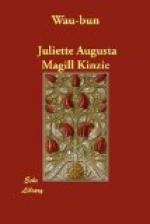I think this enumeration comprises all the white inhabitants of Chicago at a period less than half a century ago. To many who may read these pages the foregoing particulars will, doubtless, appear uninteresting. But to those who visit Chicago, and still more to those who come to make it their home, it may be not without interest to look back to its first beginnings; to contemplate the almost magical change which a few years have wrought; and from the past to augur the marvellous prosperity of the future.
The origin of the name Chicago is a subject of discussion, some of the Indians deriving it from the fitch or polecat, others from the wild onion with which the woods formerly abounded; but all agree that the place received its name from an old chief who was drowned in the stream in former times. That this event, although so carefully preserved by tradition, must have occurred in a very remote period, is evident from an old French manuscript brought by General Cass from France.
In this paper, which purports to be a letter from M. de Ligney, at Green Bay, to M. de Siette, among the Illinois, dated as early as 1726, the place is designated as “Chica-goux.” This orthography is also found in old family letters of the beginning of the present century.
* * * * *
In giving the early history of Chicago, the Indians say, with great simplicity, “the first white man who settled here was a negro.”
This was Jean Baptiste Point-au-Sable, a native of St. Domingo, who, about the year 1796, found his way to this remote region, and commenced a life among the Indians. There is usually a strong affection between these two races, and Jean Baptiste imposed upon his new friends by making them believe that he had been a “great chief” among the whites. Perhaps he was disgusted at not being elected to a similar dignity by the Pottowattamies, for he quitted this vicinity, and finally terminated his days at Peoria, under the roof of his friend Glamorgan, another St. Domingo negro, who had obtained large Spanish grants in St. Louis and its environs, and who, at one time, was in the enjoyment of an extensive landed estate.
Point-au-Sable had made some improvements at Chicago, which were taken possession of by a Frenchman named Le Mai, who commenced trading with the Indians. After a few years Le Mai’s establishment was purchased by John Kinzie, Esq., who at that time resided at Bertrand, or Parc aux Vaches, as it was then called, near Niles, in Michigan. As this gentleman was for nearly twenty years, with the exception of the military, the only white inhabitant of Northern Illinois, some particulars of his early life may not be uninteresting.
He was born in Quebec in 1163. His mother had been previously married to a gentleman of the name of Haliburton. The only daughter of this marriage was the mother of General Fleming, Nicholas Low, Esq., and Mrs. Charles King, of New York. She is described as a lady of remarkable beauty and accomplishments. Mr. Kinzie was the only child of the second marriage. His father died in his infancy, and his mother married a third time a Mr. Forsyth, after which they removed to the city of New York.




